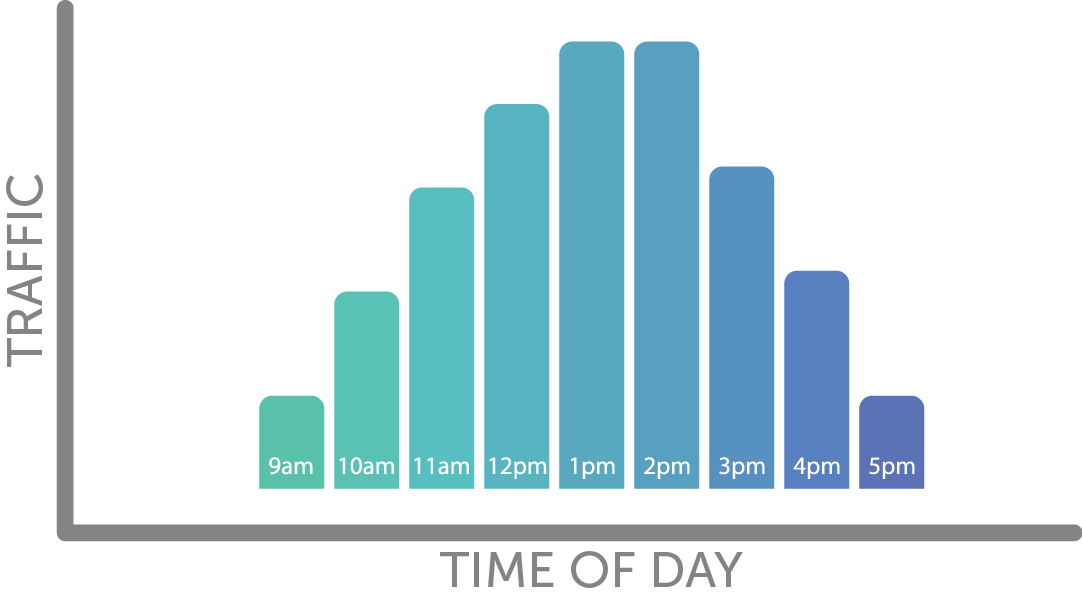Part two dives into how to increase your profit margin by using data to optimize your operating hours.
In part one of how to increase your profit margin by optimizing your operating hours, we tackled what factors you should consider when optimizing operating hours for your retail store, restaurant, or other commercial space. Some of those considerations can affect whether your hours change season to season or if there are contractual stipulations that limit what you can do.
With those considerations taken into account, we can dive into using data to optimize your store hours. Knowing which days are busiest is the first important step but to really optimize, you really need to drill down into the hourly traffic.
Study Your Traffic
Generally speaking, there are three types of hourly patterns commercial spaces which traffic volume falls into. These patterns will help you understand when you are your at your busiest and when you’re at your slowest.
Normal Distribution

This is the most common type of distribution pattern. It shows that the busiest times are in the middle of the day while the volume of customers tapers off around opening and closing hours. These hours generally indicate that the current hours have been optimized. It is possible that traffic could be busier outside of operating hours if your surveyed customers have indicated they would like to shop earlier or later. However, with normal volume distribution shown in the chart above you should be wary as it seems less likely to be the case.
High Opening Hours Volume Distribution

The next typical customer volume distribution is weighted near opening hours. Traffic peaks at the beginning of the working day and tapers off near the end. This indicates that there might be an opportunity to get more customers by opening earlier.
High Closing Hours Volume Distribution

The other side of the coin is when volume is weighted near closing hours. When traffic peaks at the end of the day it could indicate that you might be able to get more customers and a higher profit margin by staying open later in the day.
Gathering Accurate Data
Collecting accurate data is very important in order to successfully optimize your hours. Unfortunately, the human mind is easily fooled so eyeballing it may not be the best option. As an example, let’s say a retail store sees a surge of around 40 customers between 1:20 p.m. and 1:40 p.m. but otherwise very few customers come in 20 minutes before or after those times. At the end of the day, one or two customers comes in every minute and there are never more than five or six people in the store at any given time. It may seem less busy than the midday rush, but it is actually twice as busy at the end of the day.
An easy and automatic way to collect data is to use a WiFi marketing platform like Connect. It uses your existing WiFi infrastructure to count not only how many people come to your venue but also other key metrics like how long they dwelled or how many times they return to your location or visit another location.
Optimizing Your Hours

Now that you’ve collected your data, you can plan out how to optimize your hours. One strategy is to just extend your hours at the beginning or end of the day but that may not always be the best strategy. It is possible that by extending hours and promoting it to customers could just shift the timing of when they visit as the example above shows. Extending your hours by an hour or two at the end of the day, for example, may just convince a current customer to visit later in the day. So the overall volume of customers and profit margin stays the same but operating costs have increased.

There is a more efficient way of optimizing your hours. For example, if your venue is a coffee shop that peaks during opening hours (for that first in the morning coffee rush) but tapers off at the end of the day, you can possibly increase sales without increasing expense on staffing. Instead of just opening earlier, you should also experiment with closing earlier as well. Effectively, you’ll shift the last hour or two of the day to the beginning of the day. If sales are much higher at the beginning of the day, you’ve increased your revenue without increasing operating expenses.
When optimizing your hours of operation it all comes down to capturing data, studying it, and experimentation.









